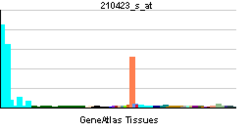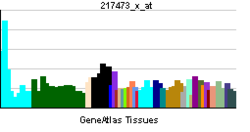- SLC11A1
-
Natural resistance-associated macrophage protein 1 is a protein that in humans is encoded by the SLC11A1 gene.[1][2][3]
This gene is a member of the solute carrier family 11 (proton-coupled divalent metal ion transporters) family and encodes a multi-pass membrane protein. The protein functions as a divalent transition metal (iron and manganese) transporter involved in iron metabolism and host resistance to certain pathogens. Mutations in this gene have been associated with susceptibility to infectious diseases such as tuberculosis and leprosy, and inflammatory diseases such as rheumatoid arthritis and Crohn's disease. Alternatively spliced variants that encode different protein isoforms have been described but the full-length nature of only one has been determined.[3]
See also
References
- ^ Cellier M, Govoni G, Vidal S, Kwan T, Groulx N, Liu J, Sanchez F, Skamene E, Schurr E, Gros P (Dec 1994). "Human natural resistance-associated macrophage protein: cDNA cloning, chromosomal mapping, genomic organization, and tissue-specific expression". J Exp Med 180 (5): 1741–52. doi:10.1084/jem.180.5.1741. PMC 2191750. PMID 7964458. http://www.pubmedcentral.nih.gov/articlerender.fcgi?tool=pmcentrez&artid=2191750.
- ^ Kishi F (Dec 1994). "Isolation and characterization of human Nramp cDNA". Biochem. Biophys. Res. Commun. 204 (3): 1074–80. doi:10.1006/bbrc.1994.2572. PMID 7980580.
- ^ a b "Entrez Gene: SLC11A1 solute carrier family 11 (proton-coupled divalent metal ion transporters), member 1". http://www.ncbi.nlm.nih.gov/sites/entrez?Db=gene&Cmd=ShowDetailView&TermToSearch=6556.
Further reading
- Blackwell JM, Searle S, Mohamed H, White JK (2003). "Divalent cation transport and susceptibility to infectious and autoimmune disease: continuation of the Ity/Lsh/Bcg/Nramp1/Slc11a1 gene story.". Immunol. Lett. 85 (2): 197–203. doi:10.1016/S0165-2478(02)00231-6. PMID 12527228.
- Awomoyi AA (2007). "The human solute carrier family 11 member 1 protein (SLC11A1): linking infections, autoimmunity and cancer?". FEMS Immunol. Med. Microbiol. 49 (3): 324–9. doi:10.1111/j.1574-695X.2007.00231.x. PMC 1890654. PMID 17378896. http://www.pubmedcentral.nih.gov/articlerender.fcgi?tool=pmcentrez&artid=1890654.
- Liu J, Fujiwara TM, Buu NT, et al. (1995). "Identification of polymorphisms and sequence variants in the human homologue of the mouse natural resistance-associated macrophage protein gene.". Am. J. Hum. Genet. 56 (4): 845–53. PMC 1801220. PMID 7717395. http://www.pubmedcentral.nih.gov/articlerender.fcgi?tool=pmcentrez&artid=1801220.
- Vidal SM, Malo D, Vogan K, et al. (1993). "Natural resistance to infection with intracellular parasites: isolation of a candidate for Bcg.". Cell 73 (3): 469–85. doi:10.1016/0092-8674(93)90135-D. PMID 8490962.
- Blackwell JM, Barton CH, White JK, et al. (1996). "Genomic organization and sequence of the human NRAMP gene: identification and mapping of a promoter region polymorphism.". Mol. Med. 1 (2): 194–205. PMC 2229945. PMID 8529098. http://www.pubmedcentral.nih.gov/articlerender.fcgi?tool=pmcentrez&artid=2229945.
- Kishi F, Nobumoto M (1996). "Identification of natural resistance-associated macrophage protein in peripheral blood lymphocytes.". Immunol. Lett. 47 (1-2): 93–6. doi:10.1016/0165-2478(95)00070-L. PMID 8537108.
- Gruenheid S, Pinner E, Desjardins M, Gros P (1997). "Natural resistance to infection with intracellular pathogens: the Nramp1 protein is recruited to the membrane of the phagosome.". J. Exp. Med. 185 (4): 717–30. doi:10.1084/jem.185.4.717. PMC 2196151. PMID 9034150. http://www.pubmedcentral.nih.gov/articlerender.fcgi?tool=pmcentrez&artid=2196151.
- Atkinson PG, Blackwell JM, Barton CH (1997). "Nramp1 locus encodes a 65 kDa interferon-gamma-inducible protein in murine macrophages.". Biochem. J.. 325 ( Pt 3): 779–86. PMC 1218623. PMID 9271100. http://www.pubmedcentral.nih.gov/articlerender.fcgi?tool=pmcentrez&artid=1218623.
- Gruenheid S, Canonne-Hergaux F, Gauthier S, et al. (1999). "The iron transport protein NRAMP2 is an integral membrane glycoprotein that colocalizes with transferrin in recycling endosomes.". J. Exp. Med. 189 (5): 831–41. doi:10.1084/jem.189.5.831. PMC 2192949. PMID 10049947. http://www.pubmedcentral.nih.gov/articlerender.fcgi?tool=pmcentrez&artid=2192949.
- Searle S, Blackwell JM (1999). "Evidence for a functional repeat polymorphism in the promoter of the human NRAMP1 gene that correlates with autoimmune versus infectious disease susceptibility.". J. Med. Genet. 36 (4): 295–9. doi:10.1136/jmg.36.4.295. PMC 1734346. PMID 10227396. http://www.pubmedcentral.nih.gov/articlerender.fcgi?tool=pmcentrez&artid=1734346.
- Marquet S, Lepage P, Hudson TJ, et al. (2000). "Complete nucleotide sequence and genomic structure of the human NRAMP1 gene region on chromosome region 2q35.". Mamm. Genome 11 (9): 755–62. doi:10.1007/s003350010151. PMID 10967134.
- Canonne-Hergaux F, Calafat J, Richer E, et al. (2002). "Expression and subcellular localization of NRAMP1 in human neutrophil granules.". Blood 100 (1): 268–75. doi:10.1182/blood.V100.1.268. PMID 12070036.
- Rodríguez MR, González-Escribano MF, Aguilar F, et al. (2003). "Association of NRAMP1 promoter gene polymorphism with the susceptibility and radiological severity of rheumatoid arthritis.". Tissue Antigens 59 (4): 311–5. doi:10.1034/j.1399-0039.2002.590410.x. PMID 12135431.
- Bassuny WM, Ihara K, Matsuura N, et al. (2002). "Association study of the NRAMP1 gene promoter polymorphism and early-onset type 1 diabetes.". Immunogenetics 54 (4): 282–5. doi:10.1007/s00251-002-0459-3. PMID 12136340.
- Søborg C, Andersen AB, Madsen HO, et al. (2002). "Natural resistance-associated macrophage protein 1 polymorphisms are associated with microscopy-positive tuberculosis.". J. Infect. Dis. 186 (4): 517–21. doi:10.1086/341775. PMID 12195379.
- Puzyrev VP, Freĭdin MB, Rudko AA, et al. (2002). "[Polymorphisms of the candidate genes for genetic susceptibility to tuberculosis in the Slavic population of Siberia: a pilot study]". Mol. Biol. (Mosk.) 36 (5): 788–91. PMID 12391841.
- Strausberg RL, Feingold EA, Grouse LH, et al. (2003). "Generation and initial analysis of more than 15,000 full-length human and mouse cDNA sequences.". Proc. Natl. Acad. Sci. U.S.A. 99 (26): 16899–903. doi:10.1073/pnas.242603899. PMC 139241. PMID 12477932. http://www.pubmedcentral.nih.gov/articlerender.fcgi?tool=pmcentrez&artid=139241.
SLC11–20 - (11) proton coupled metal ion transporter (SLC11A1, SLC11A2) 11A3
- (12) electroneutral cation-Cl cotransporter (SLC12A1, SLC12A1, SLC12A2, SLC12A3, SLC12A4, SLC12A5, SLC12A6, SLC12A7, SLC12A8, SLC12A9)
- (14) urea transporter (SLC14A1, SLC14A2)
- (15) proton oligopeptide cotransporter (SLC15A1, SLC15A2, SLC15A3, SLC15A4)
- (16) monocarboxylate transporter (SLC16A1, SLC16A2, SLC16A3, SLC16A4, SLC16A5, SLC16A6, SLC16A7, SLC16A8, SLC16A9, SLC16A10, SLC16A11, SLC16A12, SLC16A13, SLC16A14)
SLC21–30 - (21) organic anion transporting (SLCO1A2, SLCO1B1, SLCO1B3, SLCO1B4, SLCO1C1) (SLCO2A1, SLCO2B1) (SLCO3A1) (SLCO4A1, SLCO4C1) (SLCO5A1) (SLCO6A1)
- (22) organic cation/anion/zwitterion transporter (SLC22A1, SLC22A2, SLC22A3, SLC22A4, SLC22A5, SLC22A6, SLC22A7, SLC22A8, SLC22A9, SLC22A10, SLC22A11, SLC22A12, SLC22A13, SLC22A14, SLC22A15, SLC22A16, SLC22A17, SLC22A18, SLC22A19, SLC22A20)
- (24) Na+/(Ca2+-K+) exchanger (SLC24A1, SLC24A2, SLC24A3, SLC24A4, SLC24A5, SLC24A6)
- (25) mitochondrial carrier (SLC25A1, SLC25A2, SLC25A3, SLC25A4, SLC25A5, SLC25A6, SLC25A7, SLC25A8, SLC25A9, SLC25A10, SLC25A11, SLC25A12, SLC25A13, SLC25A14, SLC25A15, SLC25A16, SLC25A17, SLC25A18, SLC25A19, SLC25A20, SLC25A21, SLC25A22, SLC25A23, SLC25A24, SLC25A25, SLC25A26, SLC25A27, SLC25A28, SLC25A29, SLC25A30, SLC25A31, SLC25A32, SLC25A33, SLC25A34, SLC25A35, SLC25A36, SLC25A37, SLC25A38, SLC25A39, SLC25A40, SLC25A41, SLC25A42, SLC25A43, SLC25A44, SLC25A45, SLC25A46)
SLC31–40 - (32) vesicular inhibitory amino-acid transporter (SLC32A1)
- (33) Acetyl-CoA transporter (SLC33A1)
- (35) nucleoside-sugar transporter (SLC35A1, SLC35A2, SLC35A3, SLC35A4, SLC35A5) (SLC35B1, SLC35B2, SLC35B3, SLC35B4) (SLC35C1, SLC35C2) (SLC35D1, SLC35D2, SLC35D3) (SLC35E1, SLC35E2, SLC35E3, SLC35E4)
- (36) proton-coupled amino-acid transporter (SLC36A1, SLC36A2, SLC36A3, SLC36A4)36A2 ·
- (37) sugar-phosphate/phosphate exchanger (SLC37A1, SLC37A2, SLC37A3, SLC37A4)
- (38) System A & N, sodium-coupled neutral amino-acid transporter (SLC38A1, SLC38A2, SLC38A3, SLC38A4, SLC38A5, SLC38A6, SLC38A10)
- (39) metal ion transporter (SLC39A1, SLC39A2, SLC39A3, SLC39A4, SLC39A5, SLC39A6, SLC39A7, SLC39A8, SLC39A9, SLC39A10, SLC39A11, SLC39A12, SLC39A13, SLC39A14)
- (40) basolateral iron transporter (SLC40A1)
SLC41–48 SLCO1–4 Ion pumps Metabolism: Metal metabolism Transition metal OtherZinc metabolismElectrolyte Sodium metabolismPhosphate metabolismMagnesium metabolismM: NUT
cof, enz, met
noco, nuvi, sysi/epon, met
drug(A8/11/12)
Categories:- Human proteins
- Membrane protein stubs
- Solute carrier family
Wikimedia Foundation. 2010.



